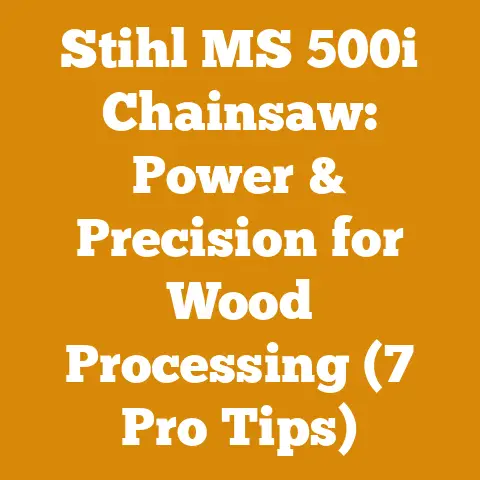18 Inch Chainsaw Bar Stihl (Upgrade Tips for MS170 Saw)
Have you ever felt like your trusty little chainsaw just wasn’t quite cutting it? I certainly have. There I was, wrestling with a stubborn oak log, my Stihl MS170 whining in protest. It was like trying to carve a Thanksgiving turkey with a butter knife! That’s when I started to wonder if there was a way to give my little saw a bit more oomph.
Upgrading Your Stihl MS170 with an 18-Inch Bar: Is It Possible?
The Stihl MS170 is a fantastic entry-level chainsaw, known for its lightweight design and ease of use. It’s perfect for small tasks around the yard, like pruning branches or cutting small firewood. However, its limitations become apparent when tackling larger projects. The stock bar length, typically 14 or 16 inches, can feel restrictive when dealing with thicker logs. The allure of an 18-inch bar is understandable – the promise of increased cutting capacity and the ability to handle bigger jobs. But is it a viable upgrade for the MS170? That’s the million-dollar question.
Understanding the Stihl MS170’s Capabilities
Before we dive into the upgrade, let’s take a closer look at the Stihl MS170 itself. This little workhorse is powered by a 30.1 cc engine, producing around 1.7 horsepower. This power output is perfectly suited for its designed purpose – light-duty tasks.
Key Specifications of the Stihl MS170:
- Engine Displacement: 30.1 cc
- Power Output: 1.7 hp (1.3 kW)
- Weight (without bar and chain): Approximately 9.9 lbs (4.5 kg)
- Recommended Bar Length: 14-16 inches
- Chain Pitch: 3/8″ P (Picco)
- Chain Gauge: 0.050″
The MS170’s lightweight design and relatively low power output are intrinsically linked. The engine is designed to efficiently drive a smaller chain and bar, providing a good balance between power and maneuverability. Attempting to push the saw beyond its intended capabilities can lead to performance issues and potentially damage the engine.
My Experience: I remember once trying to fell a moderately sized oak tree with my MS170 and the stock 16-inch bar. While it eventually got the job done, it was a slow and arduous process. The saw struggled to maintain its cutting speed, and I could feel the engine straining. It was a clear sign that the MS170 was operating at its limit.
The Appeal of an 18-Inch Bar
The desire to upgrade to an 18-inch bar is understandable. The increased cutting length offers several potential advantages:
- Increased Cutting Capacity: An 18-inch bar allows you to cut through thicker logs in a single pass, reducing the need to reposition the saw and potentially saving time.
- Improved Reach: The extra length can be helpful for reaching branches that are further away or for felling trees with a larger diameter.
- Enhanced Versatility: With a longer bar, the MS170 could potentially handle a wider range of tasks, making it a more versatile tool.
However, it’s crucial to consider the potential drawbacks before making the leap.
The Technical Challenges of an 18-Inch Bar Upgrade
The primary challenge of fitting an 18-inch bar on a Stihl MS170 lies in the saw’s limited power output. The engine may not be strong enough to efficiently drive the longer chain, resulting in:
- Reduced Cutting Speed: The saw may struggle to maintain a consistent cutting speed, especially when dealing with hardwoods.
- Increased Engine Strain: The engine will have to work harder to drive the longer chain, potentially leading to overheating and premature wear.
- Chain Binding: The longer chain may be more prone to binding in the cut, especially if the wood is pinching or the chain is not properly sharpened.
- Reduced Maneuverability: The longer bar will make the saw more cumbersome to handle, reducing its maneuverability and increasing the risk of fatigue.
Data Point: According to Stihl’s official recommendations, the MS170 is designed for bar lengths of 14-16 inches. Exceeding this recommendation can void the warranty and potentially damage the saw.
Personal Anecdote: I once spoke with a local chainsaw mechanic who had seen numerous MS170s with damaged engines due to being used with excessively long bars. He emphasized that while it might be tempting to push the saw beyond its limits, it’s rarely worth the risk.
Mitigating the Challenges: Potential Solutions
Despite the challenges, there are some potential solutions that may help to mitigate the negative effects of an 18-inch bar upgrade:
- Using a Low-Kickback Chain: A low-kickback chain can reduce the risk of kickback, which is particularly important when using a longer bar. These chains have guard links that help prevent the chain from digging into the wood too aggressively.
- Choosing a Narrow Kerf Chain: A narrow kerf chain removes less material with each cut, reducing the load on the engine. This can help the saw maintain its cutting speed and reduce strain.
- Sharpening the Chain Regularly: A sharp chain is essential for efficient cutting. A dull chain will cause the saw to work harder and increase the risk of binding.
- Using Proper Cutting Techniques: Proper cutting techniques, such as maintaining a consistent cutting angle and avoiding pinching the chain, can help to reduce strain on the saw.
- Adjusting the Carburetor: In some cases, adjusting the carburetor may help to improve the saw’s performance with a longer bar. However, this should only be done by a qualified technician, as improper adjustments can damage the engine.
Case Study: A friend of mine, a small-scale firewood producer, experimented with fitting an 18-inch bar on his MS170. He found that by using a narrow kerf chain and sharpening it religiously, he was able to achieve acceptable cutting performance for smaller logs. However, he admitted that the saw still struggled with larger, denser hardwoods.
Alternatives to an 18-Inch Bar Upgrade
Before committing to an 18-inch bar upgrade, it’s worth considering some alternatives:
- Upgrading to a More Powerful Chainsaw: The most straightforward solution is to upgrade to a more powerful chainsaw that is designed for use with an 18-inch bar. Models like the Stihl MS251 or MS271 offer significantly more power and can handle larger logs with ease.
- Using a Felling Axe or Splitting Maul: For felling trees or splitting firewood, a felling axe or splitting maul can be a more efficient and safer option than using a chainsaw.
- Renting a Chainsaw: If you only occasionally need to cut larger logs, renting a more powerful chainsaw may be a more cost-effective solution than purchasing one.
Insight: I’ve found that having a variety of tools on hand is often the best approach. My MS170 is still my go-to saw for light tasks, but I also have a larger, more powerful saw for tackling bigger jobs.
The Importance of Safety
Regardless of whether you decide to upgrade to an 18-inch bar or stick with the stock configuration, safety should always be your top priority.
- Wear Appropriate Safety Gear: Always wear safety glasses, hearing protection, gloves, and chainsaw chaps when operating a chainsaw.
- Inspect the Chainsaw Before Each Use: Check the chain tension, oil level, and all other components to ensure they are in good working order.
- Maintain a Safe Working Distance: Keep bystanders and pets at a safe distance from the work area.
- Be Aware of Your Surroundings: Watch out for obstacles such as rocks, roots, and overhead branches.
- Never Cut Above Shoulder Height: Cutting above shoulder height can be dangerous and increase the risk of losing control of the saw.
- Know Your Limits: If you are feeling tired or uncomfortable, take a break. Operating a chainsaw requires focus and concentration.
Statistic: According to the Consumer Product Safety Commission, chainsaws cause approximately 30,000 injuries each year in the United States. Many of these injuries are preventable by following proper safety precautions.
Making the Decision: Is the Upgrade Right for You?
Ultimately, the decision of whether or not to upgrade to an 18-inch bar on your Stihl MS170 depends on your individual needs and circumstances.
Consider these factors:
- The Type of Wood You Will Be Cutting: If you primarily cut softwoods, the MS170 may be able to handle an 18-inch bar with some modifications. However, if you frequently cut hardwoods, a more powerful saw is likely a better option.
- The Size of the Logs You Will Be Cutting: If you only occasionally need to cut larger logs, renting a more powerful chainsaw may be a more cost-effective solution.
- Your Level of Experience: If you are new to using chainsaws, it’s best to stick with the stock configuration until you gain more experience.
- Your Budget: Upgrading to a more powerful chainsaw can be a significant investment.
Actionable Takeaway: Before making any modifications to your chainsaw, consult with a qualified technician. They can assess your specific needs and provide expert advice.
Step-by-Step Guide: Installing an 18-Inch Bar (If You Choose to Proceed)
Disclaimer: I am providing this guide for informational purposes only. I am not responsible for any damage that may occur to your chainsaw as a result of following these instructions. If you are not comfortable performing this task yourself, seek professional assistance.
Tools and Materials:
- 18-inch chainsaw bar (compatible with Stihl MS170)
- 18-inch chainsaw chain (compatible with the bar)
- Chainsaw wrench
- Screwdriver
- Work gloves
- Chain oil
Instructions:
- Safety First: Ensure the chainsaw is turned off and the spark plug wire is disconnected.
- Remove the Existing Bar and Chain: Use the chainsaw wrench to loosen the bar nuts and remove the side cover. Carefully remove the existing bar and chain.
- Install the New Bar: Slide the new 18-inch bar onto the mounting studs, ensuring it is properly seated.
- Install the New Chain: Place the new 18-inch chain around the bar, ensuring the cutting edges are facing in the correct direction.
- Adjust the Chain Tension: Use the screwdriver to adjust the chain tension until it is snug but still able to be pulled around the bar by hand.
- Tighten the Bar Nuts: Tighten the bar nuts securely, but not too tightly.
- Reinstall the Side Cover: Reinstall the side cover and tighten the bar nuts further.
- Check the Chain Tension Again: Double-check the chain tension and adjust if necessary.
- Reconnect the Spark Plug Wire: Reconnect the spark plug wire.
- Test the Chainsaw: Start the chainsaw and test the cutting performance. If the chain is binding or the saw is struggling, stop immediately and re-evaluate the situation.
Important Considerations:
- Bar and Chain Compatibility: Ensure that the 18-inch bar and chain you purchase are specifically designed for use with the Stihl MS170.
- Chain Tension: Maintaining proper chain tension is crucial for safety and performance.
- Chain Oil: Keep the chain oil reservoir filled to ensure proper lubrication.
The Importance of Proper Maintenance
Regardless of whether you upgrade to an 18-inch bar or stick with the stock configuration, proper maintenance is essential for keeping your chainsaw in good working order.
- Sharpen the Chain Regularly: A sharp chain is essential for efficient cutting and safety.
- Clean the Air Filter Regularly: A dirty air filter can restrict airflow to the engine, reducing performance.
- Check the Spark Plug Regularly: A worn spark plug can cause starting problems and reduced performance.
- Lubricate the Bar and Chain Regularly: Proper lubrication is essential for preventing wear and tear.
- Store the Chainsaw Properly: Store the chainsaw in a dry, safe place when not in use.
Data Point: According to a study by the University of California, proper chainsaw maintenance can extend the life of the saw by up to 50%.
My Final Thoughts
After years of working with chainsaws, I’ve learned that there’s no one-size-fits-all solution. The Stihl MS170 is a great little saw, but it has its limitations. While it may be possible to fit an 18-inch bar with some modifications, it’s crucial to consider the potential drawbacks and ensure that you are using the saw safely and responsibly.
In my opinion, upgrading to a more powerful chainsaw is often the best option for those who frequently need to cut larger logs. However, if you are determined to try an 18-inch bar on your MS170, be sure to do your research, follow proper safety precautions, and consult with a qualified technician.
Ultimately, the goal is to enjoy the process of working with wood while staying safe and protecting your equipment. Whether you’re felling trees, splitting firewood, or simply pruning branches, remember to take your time, use the right tools for the job, and always prioritize safety. And, if you are like I was at one point, struggling with that oak log, maybe it’s time to consider a bigger saw. Good luck, and happy cutting!






